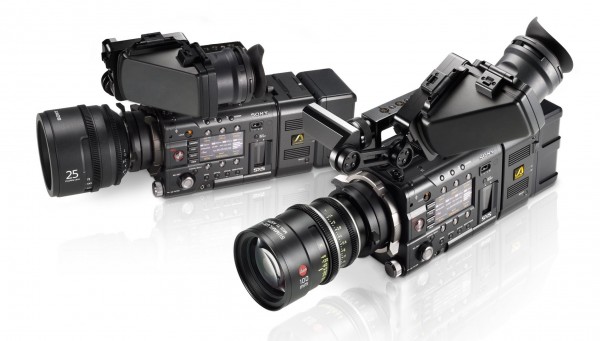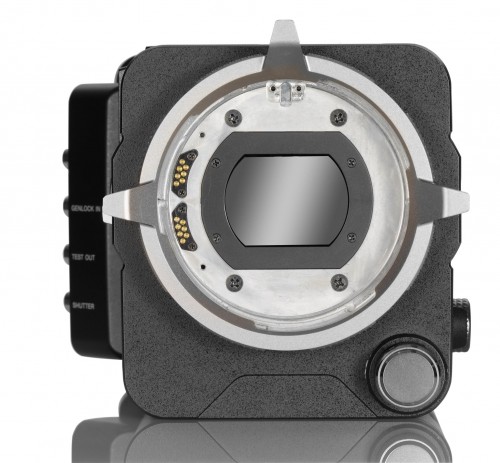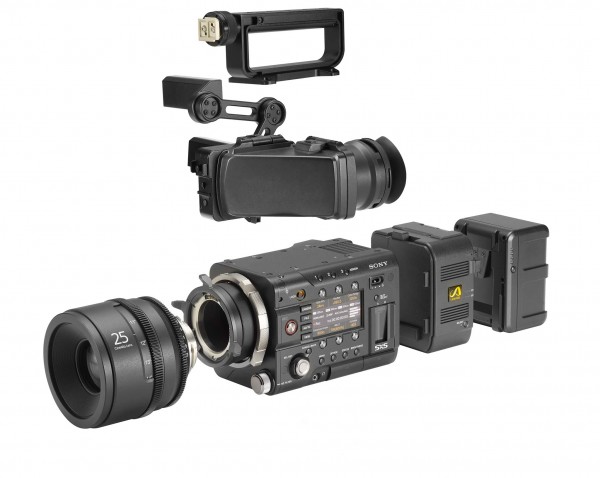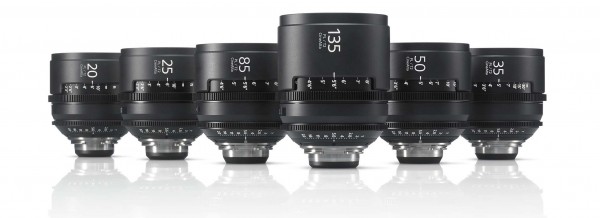By technical editor Matt Allard:

As you are probably aware, Sony have today announced two new cameras: the F5 and F55. Firstly, I’ll give you my personal opinion of these models based on the specifications: on paper these certainly look very attractive indeed, with Sony really listening to the end user and offering cinematographers two very good cameras. From workflow to viewfinders, recording formats, specifications and the modular design, Sony seems to have ticked a lot of boxes. But the proof will be in the pudding and until we see some vision or I get to actually use one, I’m not going to make any wild statements about how fantastic they are. Specs are one thing, but they never tell the whole story, as we all know. Even so, I am very excited about the potential of this camera and hope I’ll get to test one soon.
The F5 IS NOT a F3 replacement. The F3 stays in the line and the F5 and F55 simply fill the gaps between the F3 and flagship F65. The F5 and F55 look identical apart from the F55‘s silver mount. Both have the native Sony F mount, the same one that can be found on the F3. This of course means a wide range of lenses from different manufacturers can be used on these cameras with a large array of adapters. This is great for F3 owners who plan on upgrading as they can use the lenses and mounts that they already own.

Both the new cameras have a very modular design. It is best to describe them in terms of appearance as a cross between an Alexa, an Epic and an F3. Sony have certainly listened to working DPs about the design and I think they have got a lot right with the new F cameras. The F5 and F55 have both been in the works for a long time, well before the F3 came out. As far as weight goes, the body is just under 2kg, making it incredibly light.
The specs are written down for everyone to see, but I will harp on about a few things. Both can record at 50Mb/s at 4:2:2 to SxS cards – this is long overdue (and the lack of this capability was probably one of the weaknesses of the F3); 50Mb/s has become the de facto TV broadcast acquisition standard. Both cameras are also 4k and they can both record 4k. They can also record 4k RAW – slightly compressed, but about as RAW as you can get with the compression ratio of 3.6:1. For comparison (and not in regards to quality in any way as I’m not going to speculate on images from a camera I haven’t used) Spider-Man was shot on a Red Epic at 5:1 compression. So the 4K RAW is virtually uncompressed. It will record in 16bit which offers amazing tonal range reproduction and vast options in post. To put this in perspective, 16 bit retains 16 times more gradations of red, blue and green than 12bit RAW. The way it records 4k RAW is via the optional AXS-R5 recorder. ‘Oh no! Not another external recorder!’ I hear you groan. Well, while this is an optional recorder it is very small and integrates onto the camera without the need for additional power or mounts. The module is smaller than a Sony V-Lock style battery. I think this is a very smart design; for once we get something that is practical and useful to use. Snap it on if you want 4K RAW or take it off if you don’t need it. It will also record 2K RAW if you need that as well. What does it actually record to? New memory cards called AXSM (recording at up to 2.4Gb/s) which will be available in sizes up to 512GB. This same recorder will be able to be used with the FS700 as well. There is no mention of pricing yet so let’s hope it isn’t out of reach of most users.
As a footnote, the only way to record 4K to the F5 is with the AXS-R5 recorder. In the F55 you can record Quad HD (3840×2160) or 4K (4096x 2160) in camera but it will be 4:2:2 and compressed not RAW. This can be recorded to a format called XAFC which has been proposed as a 4K “standard” which we are yet to see in the industry. The XAFC will be recorded onto a new SxS Pro+ card (recording at up to 1.3 Gb/s); these new cards offer you the ability to record material at much higher data rates than the previous SxS cards. A 64GB SxS Pro+ card will get you about 20 minutes recording time if you are shooting at 4K while 2K recording will give you around 60 minutes. There is also a SR codec that will be a future upgrade that will allow 4:2:2 and 4:4:4, 10 bit recording at 220, 440 and 880Mb/s. As far as frame rates go, the F55 will be able to record up to 240fps in 2K to the optional recorder. It will currently do up to 60fps to the SxS Pro + cards but only in HD. It will however be able to do 180fps to the SxS cards with a planned upgrade. The F5 is limited to 120fps in 2K and currently it has to be recorded to the optional AXS-R5 recorder. It cannot record it internally. A planned firmware upgrade will allow the F5 to shoot it on board to SxS Pro+ cards at 120fps in 2K. The high frame rates are all available with no cropping of the sensor. Sony has also promised future firmware updates that will increase frame rates.
The other clever thing these cameras can do when it comes to recording is offer an extremely flexible, easy to use workflow once you have finished shooting. You will be able to record simultaneously to 4K or 2K RAW while at the same time recording at a different resolution to SxS cards or the new SxS Pro+
The sensors on both the F5 and F55 are the same physical size, but their characteristics are different. The F5’s CMOS chip does colour filtering in a similar way to the F3’s. The F55 sensor is closer to that of the F65 and features a global shutter. The way the F55 reads the sensor globally and not sequentially gets rid of everyone’s enemy “Rolling Shutter”. They are both supposed to have 14 stops of exposure latitude, low noise in the blacks and be outstanding when it comes to low light sensitivity. There are six standard gamma curves as well as a S-Log2 gamma curve.
There is also a range of new batteries called “Olivine” (sounds like a type of olive oil) that are supposed to be the latest and greatest in lithium batteries (Lithium Iron Phosphate to be precise). How long they last before they need to be replaced and how much they cost we don’t yet know, only that they’ll allow you to shoot for longer than conventional lithium batteries. These batteries will be able to be charged on the BC-L90 charger. The cameras are also comparable with Sony V-Lock batteries.

Sony seems to have got the viewfinders very right, with a range that come on proper mounts that are located in the right position so when you place the camera on your shoulder the viewfinder is exactly where you want it to be. The F5 comes standard with a 3.5″ LCD viewfinder with a loupe attachment that can be removed. There are two optional viewfinders: an LCD version and a 1280×720 OLED one. The F55 does not come with a viewfinder; you have to purchase one separately.
There is an optional shoulder rig that has been designed for the cameras. It looks fairly basic but it does have Arri rosettes on the sides for adding aftermarket handles etc as well as 15mm rods. We really are seeing Sony come up with its own solutions to viewfinders, mounts and even external monitors. This bucks the trend of camera manufacturers leaving everything to third party companies.

There is also a second generation of Sony PL lenses that this time features a more comprehensive set of focal lengths and a metal build. These include the 20, 25, 35, 50, 85 and 135mm lenses, all of which are rated at T2 (for those who don’t know, the T stop is the cinematic equivalent of the F-stop). They are rated for 4K and all feature the same external diameter, matte box diameter and same position for focus and iris rings. We don’t know pricing or whether the F5 or F55 will be offered with some of these lenses as a set.
There is no information on pricing yet and anything you read is pure speculation as Sony won’t say at this stage. The camera will make its public debut at the Interbee trade show in Japan in a few weeks and it will be available for purchase early next year.
About Matthew Allard, Aljazeera Senior Field Cameraman, Kuala Lumpur:
Matt has been a Camera/Editor in TV news for more 20 years, previously working for both Channel 9 and Channel 10 in Australia. Twice Network Ten Australia’s cameraman of the year as well as being a Walkley Finalist for outstanding camerawork in 2006 (for coverage of the Cronulla Race Riots) and a Logie Finalist for outstanding news coverage 2006 (Bali 9). He is a multiple ACS (Australian Cinematographers Society) award winner. His Sword Maker story that was shot on a 7D won the prestigious Neil Davis International News Golden Tripod at the 2011 ACS Awards. He has covered news events in more than 35 countries, from major sporting events to terrorist bombings. Based out of the Kuala Lumpur broadcast centre in Malaysia he is an avid user and follower of new technology, shooting stories on HD broadcast cameras, the Sony FS700 and F3 as well as Canon DSLRs.






